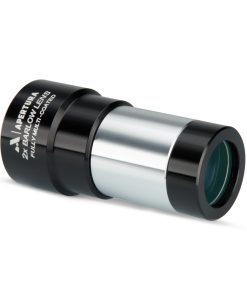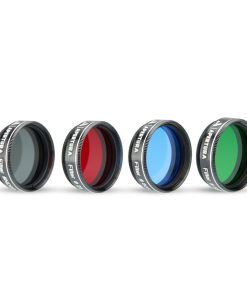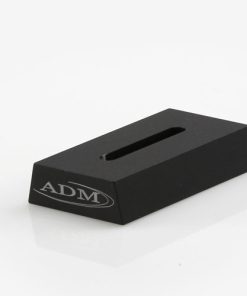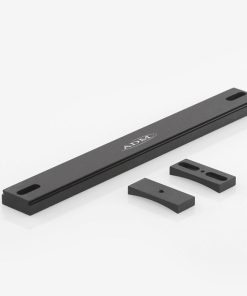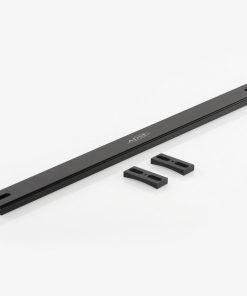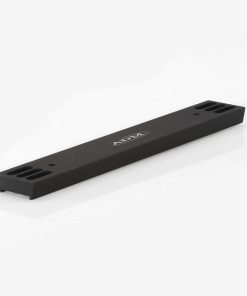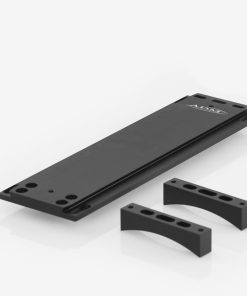Celestron Light Pollution Imaging Filter for RASA – 93617 Celestron
$ 619,95 $ 185,99
Celestron’s Rowe-Ackermann Schmidt Astrograph has made it possible for amateur astrophotographers to achieve professional-quality astroimages with a simple, affordable, compact system. But unfortunately, light pollution can sometimes stand between you and your best shot. Reduce the effects of light pollution and get high contrast images with this custom-designed Light Pollution Imaging Filter for RASA.
Precision engineering from Celestron and Astrodon
Celestron’s team set out to create the absolute best light pollution reduction filter ever designed. To achieve that goal, they joined forces with Astrodon, the world’s #1 imaging filter company. The design process started not with the filter, but with the telescope itself. For a seamless integration with the RASA system, the filter isn’t considered an “add-on” to the optical path. Instead, it replaces a piece of placeholder glass already built in.
This filter was engineered for maximum light transmission. Most light pollution filters block large swaths of the spectrum, producing dimmer images that appear overly blue or green. Astrodon’s approach eliminates only very specific wavelengths common to streetlights and other ambient light, still allowing more than 90% light transmission at many wavelengths. You preserve as much light as possible and true colors. Finally, antireflective coatings eliminate halos and internal reflections.
After each filter is complete, Astrodon individually tests it to confirm light transmission. You’ll receive a detailed spectrum report matched to your unit’s serial number inside the box, so you can be sure you’re getting the best performance.
Generous 72mm diameter
When you invest in an astrophotography system like RASA and a high-end filter like this one, you want to be confident you can enjoy it for years. Although most imaging sensors today are substantially smaller, this filter features a generous 72mm diameter, so you can be confident it will work with all the best cameras and imaging sensors of today–and tomorrow.
Quick Shipping and Professional Packaging
Due to our longstanding partnership with UPS FedEx DHL as well as other major international carriers, we are able to provide various shipping options. Our warehouse personnel are well trained and will be able to pack your goods in accordance with the exact and precise specifications. Your goods are thoroughly checked and securely secured prior to shipment. Everyday we deliver hundreds of packages to our customers from all over the world. Our determination to be the biggest online retailer in the world is shown by this. The warehouses are located situated in Europe in the same way as they are in the USA.
Note: Orders containing multiple items will have a separate processing period for each item.
We will carefully examine all products before they are shipped. Today, the majority of orders will be delivered within 48 hours. The delivery time will be between 3-7 working days.
Returns
We don't manage the stock at our warehouse and factory. The actual inventory may fluctuate at any time. It's possible that you may not receive your order once it's been placed.
Our policy is for 30 days. We are unable to return or exchange your purchase after 30 days since the purchase.
In order for your item to be eligible for return the item must not be opened and in the condition you received it. It must also remain in the original packaging.
Related products
Telescope Accessories
ADM Accessories Tripod Knob Set for Losmandy G11 & Celestron CI700 Mounts – Red – TKS-RE ADM
Telescope Accessories
ADM Accessories Vixen Style Dovetail for Celestron 9.25″ SCT – VC925 ADM
Telescope Accessories
Telescope Accessories
ADM Accessories CGEM Knob Upgrade – Two Orange Anodized Rosette Saddle Knobs – CGEM-SAD-OR ADM
Telescope Accessories
ADM Accessories Mini Dovetail Bars for Mounting – MDS-M8 ADM
Telescope Accessories
ADM V Series Dovetail Plate for Celestron 9.25″ SCT – Orange – VC925-O ADM
Telescope Accessories
ADM Accessories CGEM Knob Upgrade – Orange Tripod Knob Set – CGEM-TKS-OR ADM
Telescope Accessories
ADM V Series Dovetail Bar for Celestron 8″ SCT – Orange Anodized – VC8-O ADM
Telescope Accessories
ADM Accessories Vixen Style Dovetail for Meade 10″ SCT – VM10 ADM
Telescope Accessories
ADM Accessories Vixen Style Universal Dovetail Telescope Mounting Bar – 7″ Long – VDUP7 ADM
Telescope Accessories
Apertura 1.25″ Lunar & Planetary Filter Kit #1 – LPSET1 Apertura
Telescope Accessories
ADM V Series Universal Dovetail with 125 mm Rings – VDUPR-125 ADM
Telescope Accessories
ADM Accessories Vixen Style Universal Dovetail Telescope Mounting Bar – 3″ Long – VDUP3 ADM
Telescope Accessories
Telescope Accessories
ADM Accessories Vixen Style Universal Dovetail Telescope Mounting Bar – 14″ Long – VDUP14 ADM
Telescope Accessories
ADM Replacement Spreader Bar Knobs for Celestron Advanced VX Mount – VX-SB ADM
Telescope Accessories
ADM Accessories CGEM Knob Upgrade – Altitude Adjusting Knob – CGEM-ALT-OR ADM
Telescope Accessories
ADM Accessories CGEM Knob Upgrade – 2 Azimuth Knobs – CGEM-AZ-OR ADM
Telescope Accessories
ADM Accessories Vixen Style Dovetail for Celestron C8 – VC8 ADM
Telescope Accessories
ADM Accessories Tripod Knob Set for Losmandy G11 & Celestron CI700 Mounts – Black – TKS-BK ADM
Telescope Accessories
ADM Accessories Celestron CGX Side-By-Side Adapter – CGX-SBS ADM
Telescope Accessories
ADM Accessories Tripod Knob Set for Losmandy G11 & Celestron CI700 Mounts – Orange – TKS-OR ADM
Telescope Accessories
ADM Tripod Knob Set for Celestron CGEM DX Mount – CGEM-DX-TKS ADM
Telescope Accessories
Telescope Accessories
ADM V Series Dovetail Bar for Newer Celestron 6″ SCT – VC6 ADM
Telescope Accessories
ADM Accessories CGEM Counterweight Bar 22 Inches – CGEM-CW ADM
Telescope Accessories
Telescope Accessories
Telescope Accessories
ADM Accessories Vixen Style Dovetail for Celestron 11″ SCT – VC11 ADM
Telescope Accessories
Apertura 1.25″ Chrome Barrel for 1.25″ Eyepieces, Barlows & Diagonals – 125B Apertura
Telescope Accessories
ADM V Series Universal Dovetail with 150 mm Rings – VDUPR-150 ADM
Telescope Accessories
Apertura 1.25″ Neutral Density Filter 13% Transmission – ND96-0.9 – A-ND91 Apertura





